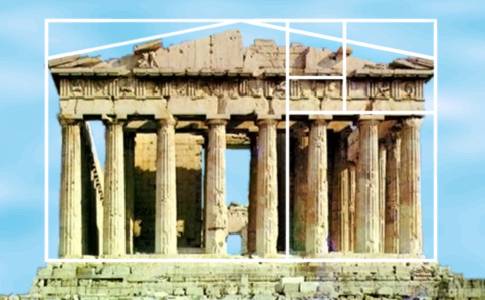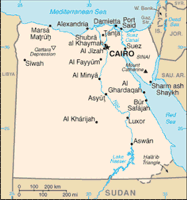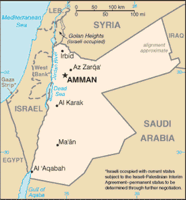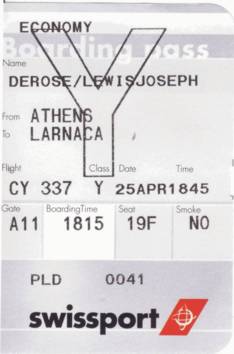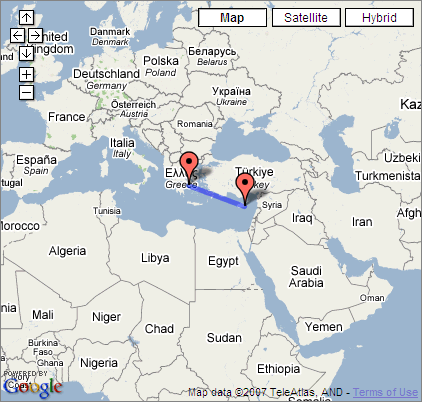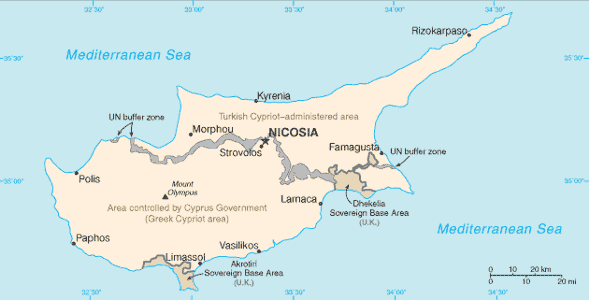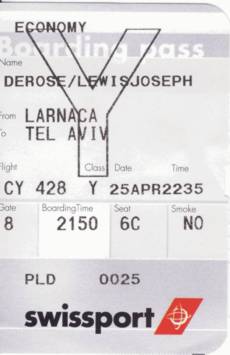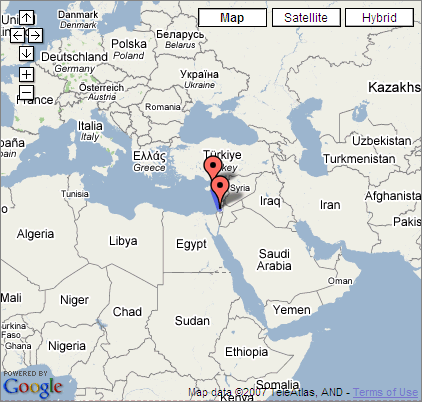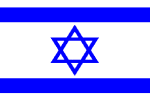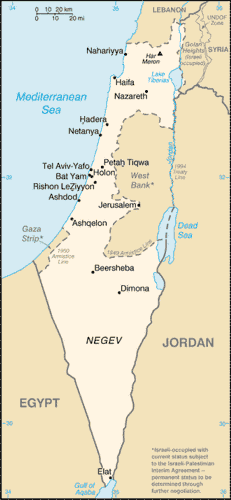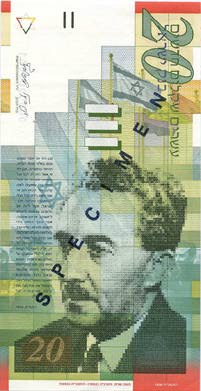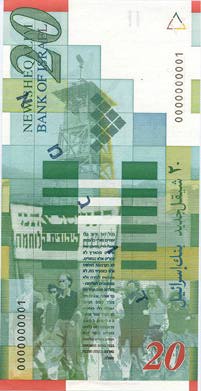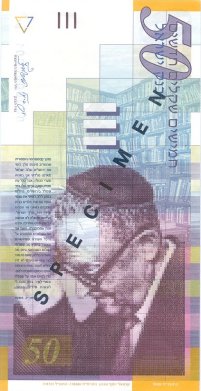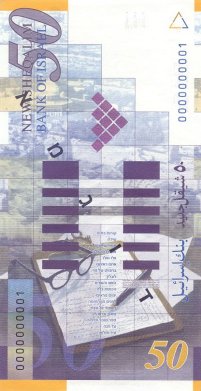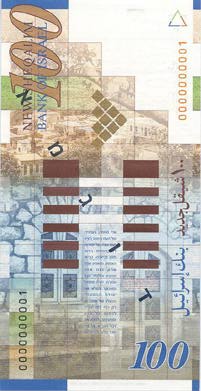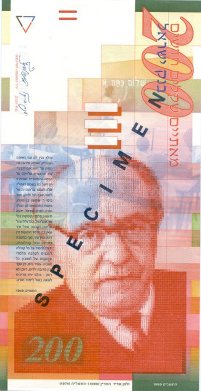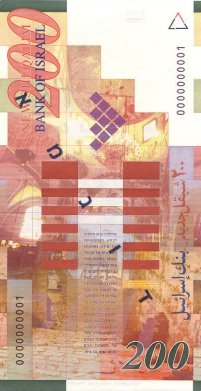Τετάρτη, κεʹΑπριλίου ͵βζʹ
| 20 | κʹ | |||
| 21 | καʹ | |||
| 22 | κβʹ | |||
| 23 | κγʹ | |||
| 24 | κδʹ | |||
| 25 | ● | κεʹ | ||
| 26 | κϝʹ | |||
| 27 | κζʹ | |||
| 28 | κηʹ | |||
| 29 | κθʹ | |||
| 30 | λʹ | |||
| 1 | αʹ | |||
| 2 | βʹ | |||
| 3 | γʹ | |||
| 4 | δʹ | |||
| 5 | εʹ | |||
| 6 | ϝʹ | |||
| Piraeus |
I slept so well on the ferry that I didn't even notice when it reached port, finally waking up to a 6:00 AM announcement. We'd probably been there for nearly an hour. I had confirmed the night before that we didn't have to disembark until about 8:30 AM, though, so there wasn't a rush. I took a quick shower, and then we repacked our bags and headed off the ship to get our bearings in
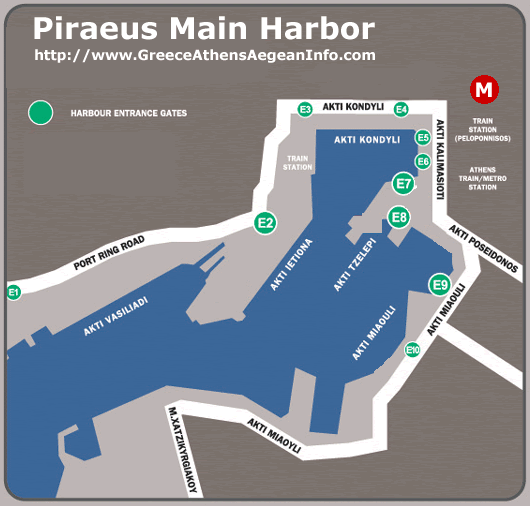 |
Pireaus |
Though a separate town, Pireaus is inextricably linked to Athens, and has been through the millennia. As far back as the Peloponnesian War, it was protected by the Athens city walls, in an amazing, dumbbell-shaped extension:
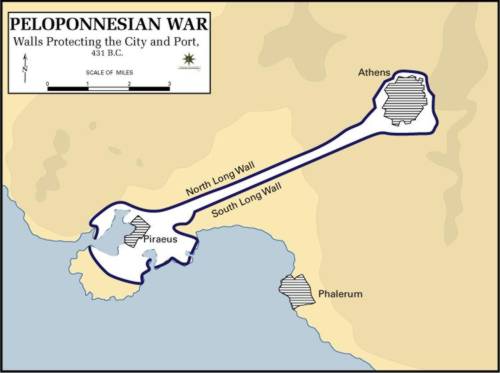 |
Athens Walls |
| The Acropolis |
At the Pireaus station we bought our tickets for the
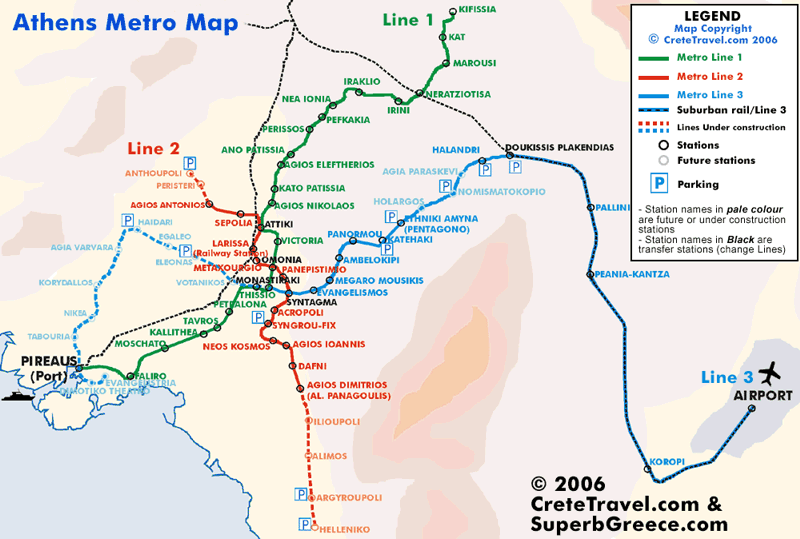 |
Athens Metro |
We bought tickets for the
|
|
From Monastiraki Square, we began our long walk to, around, and up the Acropolis – first passing the Library of Hadrian.
Library of Hadrian |
Then we skirted the
|
|
Then at long last, we entered the grounds of the
But if you hear of "The Acropolis" without further designation, you can rest assured that it's this one. Though the mountain is only 150 m (512') above sea level, it towers above relatively flat Athens – and above the history of our civilization. The monuments on it speak for themselves, but the history is no less important: This is where legend holds that the nymph
| World Heritage Site | ||||||||||||||||||||||||||||||||||||||||||||||||||||||
|
||||||||||||||||||||||||||||||||||||||||||||||||||||||
This is how Leo von Klenze imagined it looking before the ravages of time:
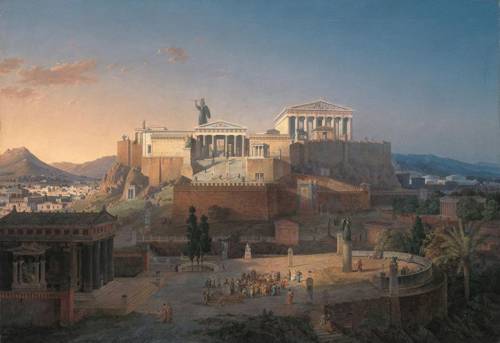 |
"Akropolis" |
We knew it wouldn't look a thing like that in 2007, but it was still an impressive site. Even the admission ticket was elaborate.
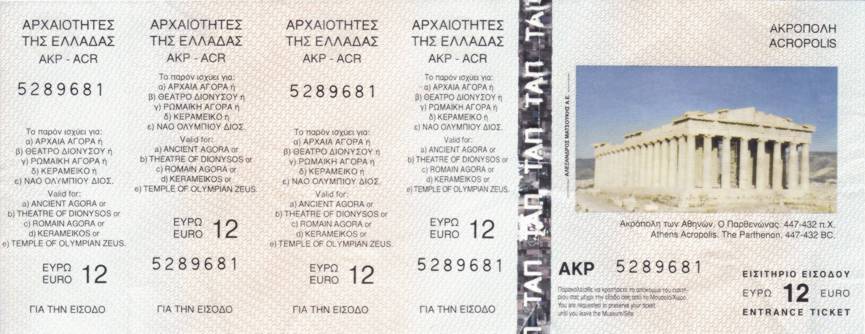 |
Admission Ticket to the Acropolis |
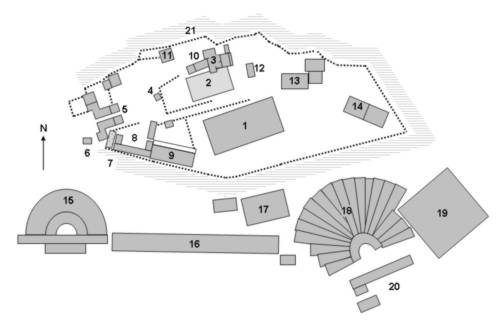 |
Acropolis |
We had the fortune (good in my opinion, 'cause I wanted to see a lot; bad in Billy's, 'cause he was exhausted) to have entered at the north side of the complex, giving us the opportunity to explore the whole site without going out of our way to do so. Our first stop was the
|
|
Then we continued around the Acropolis on the
|
|
Then we made our our way around to the South Slope.
|
First we came to the |
And then we found the crowds we had avoided, as we went with the masses past the Monument of Agrippa through the
|
|
Then we skirted the Parthenon (saving it for later), to look at the
|
|
Finally, though, we turned our attention to the
| The One in Your Mind ... | ... And the One on Top of the Acropolis |
| Graceful and majestic | Serving as but a thin membrane between the scaffolding and the tourists |
 |
Still, this is a stunning building:
|
|
The question then arises: Why does the Parthenon look like this. The answers come down to math. (This is why my trip reports are so much better than just a bunch of pictures.)
|
After getting our fill of the Acropolis – except for the Temple of Athena Nike, which was completely obscured by the restoration work – we made our way back down to the low city.
We poked around the Odeon of Herodes Atticus as much as we could, and then went in search of lunch, struggling a bit with the language barrier (and I am pleased to face such a struggle) and finally eating a forgettable lunch at an unforgettable hole-in-the-wall gyro shop. Afterward we searched for an ATM so that I could withdraw just enough in euro to get us to the airport, and then searched for the Metro (which was clearly marked on the local street map, but I didn't even notice it). We hopped on at the
|
|
| Terrorism |
So this was Day 6 of our trip, and our last day in Greece and in Western Europe (a term, by the way, which refers to the safe U.S.-aligned nations in Europe, regardless of their geographic position – which is why Greece, in the far southeastern corner of the continent, is part of it). This was the day we would depart for the Middle East.
Billy and I didn't worry too much about terrorism; I had done enough research to know that a visit to Israel (the only country on our list with a U.S. State Department travel warning) was safer than a visit to New York City. But just in case things deteriorated during our trip, I had taken the step of registering our itinerary with the State Department, which I had never done with our previous vacations.
With this subject of anti-American terrorism in mind, let's play a quick game, which will be familiar to anyone who grew up with Sesame Street:
Three of these things belong together One of these things is not like the others, Did you guess which thing was not like the others?
... is not like the others, |
Now if you got that right, the second question is why? Answer: It's not because it's the safe one.
Yes, Greece is the only country on our itinerary where the U.S. embassy was shut down while we were there! if I had been able to access my e-mail on this particular morning, I would have been able to read the following message, informing me that the U.S. embassy in Athens was closed because of a specific threat:
From: Athens, US Consulate [AthensConsul@state.gov]
WARDEN MESSAGE April 25, 2007The U.S. Embassy in Athens is closed today, April 25, because of a specific threat directed at the Embassy building. In cooperation with the Greek authorities, further information will be posted on the Embassy website as it becomes available. Contact information for the U.S. Embassy and Consulate in Greece: The U.S. Embassy in Athens is located at 91 Vas. Sophias, Athens, Greece The U.S. Consulate General in Thessaloniki is located at 42 Tsimiski Street, 7th Floor 54623 Thessaloniki. American Citizens Services Section, 2310-242-905/6/7 ext. 3104. The internet address is http://www.usconsulate.gr In case of an emergency when the Embassy or Consulate General is closed, an American in Greece can call 210-729-4444, and ask to speak to a consular officer concerning that emergency. |
| Greece |
This is, however, not to disparage Greece in any way whatsoever. Rather, it is to disparage our preconceptions about foreign environments and about terrorism. We might be forgiven for stereotyping if the stereotypes provided any accurate guidance whatsoever – but they do not.
And indeed, just as the stereotypes about Greece being a better place with regard to terrorism are wrong; so are the stereotypes about Greece being a worse place in quality of life. Two very unexpected things about this country are that it is amazingly clean and surprisingly free of beggars. It's true that Iraklio and Athens carry a layer of grime that one sees in all cities – or, at least, all the cities I have ever visited. In fact, I think it may be possible to assess the age of a city by measuring the depth of its grease layer. But Greeks are conscientious about using trash cans and the state of their streets bears witness to this dedication. The Athens Metro practically sparkles. More surprising (after visiting Italy twice, and living in America) is the lack of people begging on the street. In our entire time in Greece we saw only two people begging – and, even more unexpected, these were not in some busy Athens square but rather on an uncrowded side street in well-heeled Oia.
 My final observation on Greece is that it runs extremely well. When Athens won the 2004 Olympic Games there were doubts about its infrastructure (a belief that also helped Atlanta best Athens for the Centennial Olympic Games). But such a problem has either been completely overcome by the Greek government, or never existed in the first place. I suspect the latter as we visited places outside the main Olympics staging area, and they were no less efficient than Athens. But the upshot is this: If ever you find someone who claims to have been here, and who describes Greece as filthy, incompetent, or backward, you know that you have found a liar. Greece is a gem. And as I sat in the Athens airport waiting to check in for the flight to Jerusalem, and typed the first draft of this report on my Treo, I already knew that I was eager for my return to this amazing country.
My final observation on Greece is that it runs extremely well. When Athens won the 2004 Olympic Games there were doubts about its infrastructure (a belief that also helped Atlanta best Athens for the Centennial Olympic Games). But such a problem has either been completely overcome by the Greek government, or never existed in the first place. I suspect the latter as we visited places outside the main Olympics staging area, and they were no less efficient than Athens. But the upshot is this: If ever you find someone who claims to have been here, and who describes Greece as filthy, incompetent, or backward, you know that you have found a liar. Greece is a gem. And as I sat in the Athens airport waiting to check in for the flight to Jerusalem, and typed the first draft of this report on my Treo, I already knew that I was eager for my return to this amazing country.
Billy and I had dinner at the airport: pizza with three kinds of pork, because we thought it would be our last chance until we were back in America. (Little did we anticipate that there would be a restaurant just outside our hotel in Jerusalem proudly offering ham sandwiches.)
And since I've praised the Greeks so lavishly, I'm not going to restrain myself from a bit of criticism: Their air travel facilities demonstrate what is, in my personal view, an inappropriate comfort level with individuals who did not finish their flights successfully. I was already nonplused by the fact that Olympic Airlines's reward program is named the "Icarus Club." Then I ate my three-pork pizza under a montage of Amelia Earhart photographs. And just left of Amelia was a similar montage: enlargements of a frame from one of those grainy black-and-white early-attempts-at-flight films showing a man leaping off a cliff attached to one of those contraptions with sinewy wings rigged to a frail exposed wood skeleton; like Amelia smiling as she posed on the wing of her Lockheed 10E Electra, it was not horrifying in itself. But anyone who has watched the filmstrips at the local science museum knows that he landed abruptly at the bottom of that cliff in an oozing entanglement where about half of the sinews and frail exposed skeleton were his own.
Waiting for our flight, I finally got a chance to practice Arabic with a Saudi fashion worker and his Syrian friend. They were transferring through Larnaca to Riyadh as we were transferring to Tel Aviv. Considering that Saudia Arabia is hostile to Israel, and Syria is officially at war with it, I was surprised at what a non-issue my travel plans were in this conversation.
At the Athens airport, about 75 minutes later than scheduled, I did something I suspect few (if any) reading this have done: I boarded a Cyprus Airways plane. I'm prepared to make this claim because the in-flight magazine, SunJet, lists the airline's full inventory:
- 2 Airbus A330-200s,
- 2 Airbus A319-100s, and
- 7 Airbus A320-200s (the plane we were on).
Despite its size, though, I found this airline extremely impressive. The delay threatened our transfer to Tel-Aviv, but the staff was conscious of the situation and kept us both informed and reassured. The articles in SunJet were enjoyable as well, with shaded panels guiding the eye as to which part is in English and which is in Greek. As for the former, it is translated by someone who clearly has an ear for the richness and poetry of both languages, viz.:
"A TRIP INTO THE MOUNTAINS WILL PROVIDE A refreshing change from the heat of the beaches, with delightfully fresh air, cool breezes scented with the aroma of pine trees and wild herbs. The fruit blossom in the fertile valleys must be seen to be believed, cherry, apple, pear, plum, almond. The mountains are dotted with picturesque little villages where true Cypriot hospitality abounds, where the donkey is a cherished beast of burden and where the nectarean village wine, untouched by chemical or mechanical methods, can be sampled." – SunJet |
It makes me want to spend some time in Cyprus. Now mind you, they are not above a little puffery: The same magazine describes sites in Cyprus, and states that Hala Sultan Tekke, near Larnaca, is the "3rd most important site for Muslims, after Mecca and Medina." This is a claim disputed by – let's say – more or less the entire Muslim world, which jealously guards its control of the Haram ash-Shareef in Jerusalem with the identical claim.
|
|||||||||
1 hour, 35 minutes |
|
||||||||
|
|||||||||
|
|
I loved Cyprus Airlines on the first flight. And I think I could love Cyprus too; I really want to come back here. The name likely comes from the same root as "copper," as that's what the island was known for. This is, in fact, why the outline on the flag is copper-colored. Unfortunately, that outline doesn't tell the whole story: On most maps of the island, the uninhabited UN buffer zone is clearly marked – like the ragged ear-to-ear cut of one of the Carver's victims on Nip/Tuck. One can pass with relative ease through the gate in the bisected capital of
I'm pretty sure we got on the exact same plane for the trip to Tel-Aviv, but my seat was a less prime bit of real estate and reflected perhaps more accurately the age (and lengthy chain of ownership?) of the plane.
|
|||||||||
55 minutes |
|
||||||||
|
|||||||||
|
|
| Israel |
Having heard endless horror stories regarding Israeli security procedures, I was prepared for just about anything – just about anything, that is, except for "nothing." This is what happened: We exited in Larnaca. I saw the guys again in the transfer hall and practiced more Arabic. We were shuttled to another part of the terminal. We passed through one metal detector to enter the terminal, and another to enter the gate area (the only real nod to heightened security). I triggered the alarm. The guard looked at my belly button and patted my thighs. And that's it; I was in! But then I had to go to the bathroom, so I left the gate area (with permission) and went to the restroom down the hall. (The Larnaca restrooms are cavernous, by the way, but that's beside the point.) When I returned, they didn't even want me to empty my pockets – so my camera, PDA, belt buckle, and stack of euro coins triggered the alarm. The guy looked quickly at my belly button again (and nothing else) and I was cleared for take-off.
As for Ben Gurion – first impression: it's gorgeous; second impression: lines were long and slow moving, but security did their best; third impression" questions were the least intense version of the "grilling" I could imagine – "Why are you here?" "Where are you staying?" "When will you leave?" Look at passport for a couple of minutes. Then stamp it. So with almost no scrutiny whatsoever, we were in Israel.
I don't normally like to shut doors of opportunity, but with this particular passport stamp I became subject to what is knows as the "Israeli passport stamp stigma." This means, essentially, that because my passport shows evidence of a visit to Israel, I am officially barred from travel to various countries that still consider themselves in a state of war against Israel (or that enforce the ban out of solidarity, but without a formal declaration of war). In theory, I could have avoided this by jumping through a lot of hoops, which essentially boil down to
- Having Israel stamp my entrance and exit on a separate piece of paper;
- Having Jordan stamp my entrance on a separate piece of paper (as it would otherwise be obvious that I had entered from a checkpoint on the Israeli border); and
- Having Jordan stamp my exit on a separate piece of paper (as a departure from Jordan without an entrance to Jordan would be taken as a sign of obfuscating a visit to Israel).
In practice, this adds a lot of anxiety that I didn't need: Anybody along the line could absentmindedly stamp the passport, or simply refuse to stamp the separate paper. And Israel sometimes delays entry – by hours – for people who request this special treatment.
But my decision was more high-minded: I'm proud to have visited Israel. And while there are things I would like to see in all of these nations, I'm not going to lie to get to them. I hope they and Israel make peace, but until that happens I'll honor their wishes and stay away.
Or I could simply get a new passport (or a second passport). This is how most people get around the issue – but I'm hoping to wait out the peace process.
| The Israeli Passport Stamp ... | ... And the Israeli Passport Stamp Stigma |
| Preventing travel to Lebanon, Syria, Iran, Yemen, Sudan, and Libya. | |
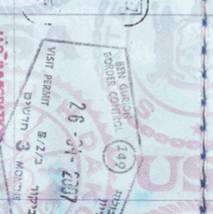 |
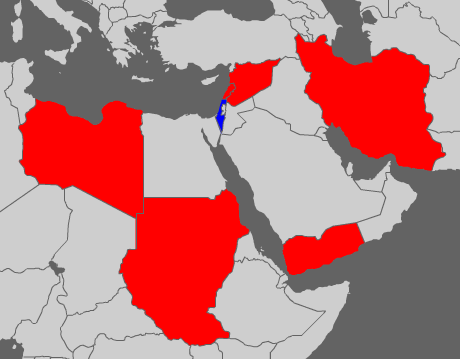 |
If you've ever traveled with me, you should not have any trouble with the question, "What is the first thing Joe does when he enters a foreign country?" If you haven't, the answer is: Load up on the local currency. So I made a bee-line from customs to the nearest ATM, and filled my wallet with the
Anyway, this is the best new currency I've handled since Switzerland; it actually may be the best ever: It's pretty; it's printed on good paper; it has interesting security features; it is written in Hebrew, Arabic, and English; it has a unique currency symbol ("₪"; printed after the number – i.e., to the left of the number in Hebrew; to the right in English). The new sheqel was immensely satisfying.
|
|||||||||||||||
By now it was quite late (almost 1:00 AM), so we immediately put ourselves to the task of spending that money on a sherut to Jerusalem, so we could check into the hotel and sleep for what was left of the night. Ordinarily, the sherut would wait until it was filled with passengers going to the same destination, but with the late hour and small crowds our driver departed immediately. As far as I can tell, the amount he charged us (100.00 ₪ each) was reasonable and didn't reflect some huge surcharge for running a mostly empty sherut.
The driver was great: genial; fun-loving; visibly Orthodox. He spoke almost no English, but we tried to make do. Just outside the airport gates, he pointed to the dashboard and said, "waffle." I was trying to make sense of this word, and it took me a while (and further gestures toward a foil pouch on the dashboard) to understand that he was actually offering me a waffle.
Now, the argument can be made that he spoke clearly and I should have understood without effort. But I stand by my position that the most logical assumption was that this person, who spoke precious little English, would not know the word "waffle" and must have been saying something else. Hell, I can carry on a conversation in six languages other than my own (and have some background in two more), but I don't know the word for "waffle" in any of them – or I didn't until I looked it up for this report:
- Spanish: la galleta
- American Sign Language: ØWɒɑɒB
(That's Skokoe Notation, by the way; until I used it here, you were more likely to see a yeti.) - French: la gaufre
- German: die Waffel
- Italian: la cialda
- Arabic: بسكويت الوفل
- Esperanto: la vaflo
- Greek: τηγανίτα
It is also worth remembering that cab drivers don't ordinarily offer waffles to their passengers.
Then, about 30 km outside of Jerusalem he asked if I wanted to drive. At first I demurred – but when the offer was repeated, I realized he was serious and jumped at the chance. How often does one get the opportunity to say, "I drove a sherut to Jerusalem"? So he pulled to the shoulder and I took the wheel.
In retrospect, maybe this was reckless: It was the middle of the night in an unfamiliar war-torn country. I had no idea how to behave at the police checkpoints (or that I was even supposed to stop until he started making enthusiastic braking gestures). But he talked us through; the police didn't seem to think it was weird that I was driving; and we continued.
Street Signs in Israel |
There was confusion on his part as to whether we wanted Jaffa Road or Jaffa Gate. And the language barrier prevented me from communicating this information in any way that was meaningful to him. I had not wanted to test the waters in Arabic because of the political overtones – but finally, in desperation, I gave it a try. He understood a bit and took no offense at all (if anything, he seemed confused as to why I had been holding back), and was able to steer me along the right path to the Old City walls and right past the Jaffa Gate. I remember an expressway, and a confusing exit, and a lot of roundabouts, and then being amazed to realize that I was actually inside the walls.
I paid him the 200 ₪ ($49.16) fare with the recently withdrawn new sheqalim, but to avoid breaking another 100 ₪ bill, I asked if I could tip him in euro. He seemed genuinely ecstatic; when I handed him about € 7 ($9.53), he thanked me enthusiastically and repeatedly.
So far, Israel was nothing like I had expected.
We walked to the hotel a block away and repaired to our room. Billy went to sleep right away. I stayed up until 2:30 AM writing the first draft of this report while it was fresh in my mind. This was a day I didn't want to forget, and there was a lot to write down. It seemed like ages ago that we got off the ferry in Pireaus.
| Main | ||||||||
| 20 | κʹ | |||||||
| 21 | καʹ | |||||||
| 22 | κβʹ | |||||||
| 23 | κγʹ | |||||||
| 24 | Previous | Προγενέστερος | κδʹ | |||||
| 25 | κεʹ | |||||||
| 26 | Next | הבא | ח׳ | |||||
| 27 | ט׳ | |||||||
| 28 | ١٠ | |||||||
| 29 | ١١ | |||||||
| 30 | ١٢ | |||||||
| 1 | ١٣ | |||||||
| 2 | ١٤ | |||||||
| 3 | ١٥ | |||||||
| 4 | ١٦ | |||||||
| 5 | ١٧ | |||||||
| 6 | ١٨ | |||||||

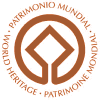


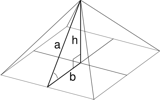 And phi can be important in pyramid design: For example, a pyramid in which the measurements can be factored to a semi-base:height:apothem ratio (b:h:a in the illustration) of 1:√
And phi can be important in pyramid design: For example, a pyramid in which the measurements can be factored to a semi-base:height:apothem ratio (b:h:a in the illustration) of 1:√
